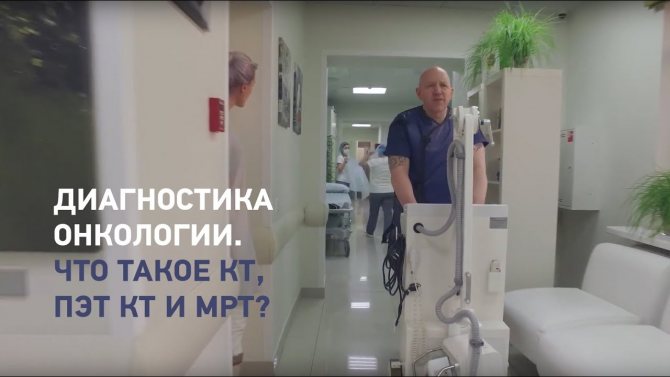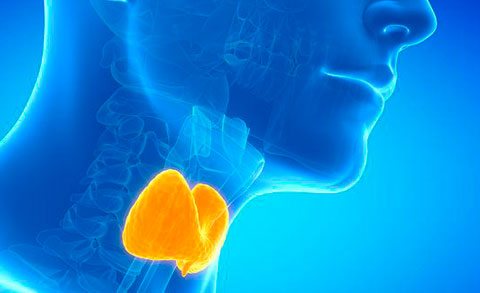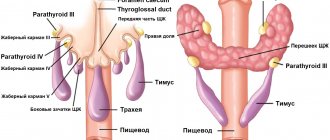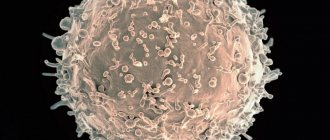Causes and risk factors for thyroid cancer
The reasons why oncology develops are still under study. It is known that cancer is a consequence of the development of genetic mutations in cells, which lead to their rapid growth. Malignant cells form a tumor, penetrate into surrounding tissues, and spread throughout the body.
Studies show that in 80% of cases, thyroid cancer occurs due to an existing disease. This may be an enlargement of the thyroid gland, the formation of benign nodes (goiter) and other inflammatory or chronic pathologies.
In addition, risk factors for developing cancer may also include :
- prolonged exposure to radiation, high background radiation in the region;
- X-ray or ionizing radiation in the head and neck area;
- chronic iodine deficiency in the body;
- adenoma, which is a precancerous disease;
- long-term development of inflammatory or tumor processes in the mammary glands or genitals;
- hereditary predisposition to the formation of malignant tumors, a family history of thyroid cancer;
- conditions that cause a sharp change in the hormonal balance in the body in women - pregnancy, lactation, menopause, etc.
Most often, the development of oncology is facilitated by a complex of factors, the combination of which plays a decisive role in the formation of the tumor. Source: Differentiated thyroid cancer. Beltsevich D.G., Mudunov A.M., Vanushko V.E., Rumyantsev P.O., Melnichenko G.A., Kuznetsov N.S., Podvyaznikov S.O., Alymov Yu.V., Polyakov A. P., Fadeev V.V., Bolotin M.V., Sevryukov F.E., Krylov V.V., Fedenko A.A., Bolotina L.V., Zharov A.A., Falaleeva N.A. ., Filonenko E.V., Nevolskikh A.A., Ivanov S.A., Khailova Zh.V., Gevorkyan T.G. Modern oncology, 2021. p. 30-44.
Signs and symptoms
In the first stages of thyroid cancer, symptoms are almost invisible and signs are completely absent. Often the first factor that causes concern for the patient is the presence of a nodular tumor in the neck.
Nodules in the gland are very common, and only 5% of them are malignant. Despite the fact that the presence of a lump is not a direct indicator that a malignant process is developing in the thyroid gland, already at this stage you should definitely consult a doctor for examination.
As thyroid cancer develops, the severity of its manifestations also increases. The patient appears:
- causeless cough;
- dyspnea;
- choking, sore throat;
- pain in the neck;
- swallowing dysfunction;
- hoarseness of voice, change in timbre;
- sweating;
- excessive fatigue, weakness;
- weight loss due to lack of appetite;
- enlarged lymph nodes.
If any of these symptoms appear and complaints persist for two or more weeks, you should definitely seek help from a doctor. This must be done even if no lump or knot is palpable in the area.
Symptoms
The disease can manifest itself with various symptoms. They depend on the stage, extent of the tumor process and complications that have developed. Small tumors of the thyroid gland are usually not accompanied by clinical symptoms and are detected incidentally during ultrasound examination. The first reason for visiting a doctor may be an enlargement of one cervical lymph node, which upon further examination turns out to be a metastasis of thyroid cancer.
Symptoms of thyroid cancer are often similar to the symptoms of colds, sore throats, and infectious diseases:
- Swelling in the neck. Small nodules in the neck can only be identified by a doctor, but sometimes swelling can be noticed during swallowing.
- Enlarged cervical lymph nodes. However, this symptom often accompanies a cold or sore throat and is not associated with a malignant process.
- Changing the timbre of the voice. Sometimes a large thyroid nodule puts pressure on the larynx, which can cause hoarseness.
- Dyspnea. The reason may be that the enlarged thyroid gland causes a narrowing of the tracheal lumen.
- Difficulty swallowing. Also, a thyroid nodule can put pressure on the esophagus.
- Pain in the neck or throat. The development of thyroid cancer rarely causes pain, but when combined with other symptoms, it is a signal to see a doctor immediately.
Most of these symptoms are associated with the appearance of a thyroid nodule, which in more than 95% of cases turns out to be benign. Thyroid nodules are quite common, and the risk of their occurrence increases in old age. If nodules are found in the thyroid gland, you should consult a doctor.
Types of thyroid cancer
Classification of thyroid cancer is carried out depending on the histological form of the tumor. The degree of malignancy of the cancer process, the level of involvement of surrounding tissues and organs in it, the rate of development of oncological processes, the degree of manifestation of symptoms and the prognosis of cure depend on the specific type of cells that make up the tumor.
Experts identify five main types of thyroid cancer :
- Papillary – diagnosed in 60-70% of patients. It is characterized by slow development and in 80-90% of cases affects only one lobe of the gland. Often metastasizes to the cervical lymph nodes. The prognosis is relatively favorable provided that the tumor is less than four centimeters in diameter and there are no metastases to distant organs. The most commonly diagnosed form of the disease in patients aged 30 to 50 years Source: Papillary thyroid cancer. Farkhutdinova L. Doctor, 2021. p. 16-19.
- Follicular – occurs in 15-20% of cases. Most often caused by a lack of iodine in the body. In most cases, the tumor does not metastasize. Rarely, malignant cells can be found in lymph nodes, lungs, and bones. The prognosis is less favorable than for papillary cancer. This form of cancer most often affects people over 50 years of age.
- Medullary, or carcinoma, is found in 5% of cases. A malignant form that early metastasizes to the lymph nodes, lungs, and liver. The neoplasm grows not only in the thyroid tissue, but also in the muscles, trachea, and lungs. Carcinoma is more aggressive than the papillary and follicular types of the disease. Occurs in patients of all agesSource: Hereditary medullary thyroid cancer. Nuralieva N.F., Yukina M.Yu., Troshina E.A., Danilova A.V. Consilium Medicum, 2021. p. 74-78.
- Anaplastic is a rare form of cancer that occurs in only 2-3% of cases. Often the cause of development is chronic nodular goiter, in which malignant processes begin to develop over time. Characterized by rapid growth, damage to cervical structures and mediastinal functions. Rapid development leads to a poor prognosis, especially if the tumor is diagnosed in elderly patients. Typically affects people over 60 years of ageSource: Undifferentiated thyroid cancer. Gostimsky A.V., Romanchishen A.F., Gavshchuk M.V. Bulletin of surgery named after I. I. Grekov, 2021. p. 113-117.
- Lymphoma - develops in 2-3% of patients. It is characterized by a rapid increase in the size of the thyroid gland and the involvement of lymph nodes in the neoplastic process. It responds well to radiation and radioiodine therapy. Often occurs in elderly patients.
In approximately 5-10% of cases, mixed forms of cancer occur, which combine the characteristics of two or more of the listed types of oncology.
Types of Thyroid Cancer
Four types of thyroid cancer are classified according to histological forms: papillary, follicular, medullary and anaplastic.
Papillary cancer is the most favorable type. It occurs in children and adults, most often falling ill at 30-40 years of age. It is the predominant form of thyroid cancer in children. The tumor most often occurs in one of the lobes, and only 10-15% of patients have bilateral involvement.
Papillary carcinoma is characterized by rather slow growth. Metastasizes to the lymph nodes of the neck; distant metastases to other organs are rare.
Follicular cancer occurs in adults with a peak incidence at 50-55 years of age. This type of tumor is characterized by slow growth. In later stages, it forms metastases in the lymph nodes of the neck, as well as in the bones, liver and lungs. Metastases of follicular cancer retain the ability to take up iodine and synthesize thyroglobulin.
Medullary cancer can be either an independent disease or a component of MEN syndrome. It is more often detected in the elderly age group of patients with nodular goiter. It is characterized by rapid growth with invasion of nearby organs and early metastasis.
Anaplastic cancer occurs more often in elderly patients with nodular goiter. It is distinguished by its aggressive form and early metastasis. The rapid growth of a tumor node can lead to its necrotic decay, ulceration and can serve as a source of bleeding.
Stages of cancer
The stage of thyroid cancer shows at what stage its development is and how far the tumor process has spread throughout the body. This is the most important factor by which treatment tactics and prognosis are determined.
Oncology staging is carried out according to a standardized system. There are four main stages in the formation of the neoplastic process:
- the first is the earliest stage of thyroid cancer, in which the neoplasm is localized, does not damage the thyroid capsule and does not metastasize;
- second (a) – the clinical picture is manifested by a single tumor that deforms the thyroid gland, or multiple neoplasms that do not damage the capsule;
- second (b) – the neoplasm gives unilateral metastases to the lymph nodes;
- third - a malignant compaction grows into the capsule, compresses surrounding tissues and organs, and also spreads pathological cells into the lymph nodes;
- the fourth is the most advanced stage, in which the tumor affects tissues and organs, gives bilateral metastases to the lymph nodes, distant organs - liver, lungs, etc.
Oncology staging is also carried out according to the international TNM system. According to this system, each letter of the abbreviation indicates the neglect of certain oncological processes in the body:
- T – degree of prevalence of cancer in the thyroid gland;
- N – presence of regional metastatic foci in nearby lymph nodes;
- M – presence of distant metastases in organs.
Each letter is assigned a corresponding index, which allows you to stage the tumor and predict the effectiveness of therapy depending on the advanced stage of development of a particular oncological process.
Methods for detecting metastases
If cancer is suspected, first of all, an ultrasound is performed, during which both the thyroid gland itself and the regional lymph nodes are examined. If they are enlarged (affected by metastases), then a targeted fine-needle aspiration biopsy is performed under ultrasound control, followed by determination of the level of tumor markers in the aspiration needle washout. In this case, the marker for well-differentiated (follicular and papillary) thyroid cancer is thyroglobulin, and for medullary cancer - calcitonin.
The following localization is typical for distant metastases of malignant tumors of the thyroid gland:
- Lungs.
- Bone.
- Abdominal organs: liver, adrenal glands, etc. (typical for medullary cancer).
- Brain (rare).
Based on this, if a patient is suspected of having thyroid cancer, it is necessary to perform an ultrasound diagnosis of the abdominal cavity, as well as the retroperitoneal space. The examination standards for suspected distant metastases or regional metastases in the mediastinum and retrosternal lymph nodes also include CT of the chest and abdomen with intravenous contrast. In order to exclude metastatic lesions of bone tissue, osteoscintigraphy is used.

Diagnostic methods
The adequacy of further therapy depends on the clinically correct determination of the type and stage of thyroid cancer. Diagnostics is the most important stage that determines the effectiveness of treatment and control of oncology in general. Source: Diagnosis of early thyroid cancer. Shatalova L.S., Kozlova Yu.G., Gaflanova D.M., Selyutin S.A. Bulletin of Medical Internet Conferences, 2020. p. 61-63.
To competently study the disease, the coordinated work of experienced specialists is necessary: an endocrinologist, an oncologist, a therapist. To make a diagnosis of thyroid cancer, the following procedures and tests are used:
- Physical examination. The doctor evaluates the physical changes that have occurred in the organ and feels the lump if it can already be felt with the fingers. At this stage, the patient is also interviewed. The specialist analyzes information about risk factors, exposure to radiation, and the presence of tumors in close relatives. After examination and questioning, the doctor refers the patient for further examination.
- A blood test for the hormones produced by the thyroid gland - thyroid-stimulating hormone, triiodothyronine, thyroxine, etc. It allows you to identify the characteristics of the gland and detect deviations in the production of hormones.
- Blood test for tumor markers. The presence of tumor markers indicates the likelihood of developing a certain form of cancer.
- Ultrasonography. Provides the opportunity to detect the presence, number and size of nodes, to study the features of their contents and blood supply. It does not allow one to distinguish benign from malignant lumps with high accuracy, and therefore requires additional research.
- Radionuclide testing, or scintigraphy. Allows you to clarify the extent of cancer.
- Fine needle aspiration puncture biopsy. Involves taking samples of the tumor. To do this, under the control of an ultrasonic sensor, a thin needle is inserted into the pathological area and tissue is removed through it. The samples are then analyzed in a laboratory to look for cancer cells. The method allows you to obtain the most accurate data about the type of tumor, its stage and characteristics.
- Computer, magnetic resonance, positron emission tomography and other imaging research methods. They are prescribed to identify metastases in other organs and systems.
- Genetic testing. In some cases, the doctor may order tests that will help identify genes that increase the risk of cancer. The test is mainly needed for people who already have a family history of thyroid tumors.
Before diagnosing thyroid cancer, the doctor must carry out a differential diagnosis, eliminating the possibility of the presence of benign tumors and other pathologies that have symptoms similar to oncology. To make a diagnosis, it is not at all necessary to undergo the entire list of tests. The specialist examines each medical case and prescribes only those tests that are necessary for a particular patient.
Treatment methods
The choice of therapeutic regimen is entirely based on diagnostic results. When drawing up a treatment plan, doctors take into account the type of tumor, its stage, the presence of metastases, as well as the patient’s overall health, chronic diseases or complicating factors. Source: The effectiveness of diagnosing thyroid cancer. Varganov M.V., Pronichev V.V., Ledneva A.V., Kostareva E.Yu., Zagrebina N.I., Sukhanov S.A., Goloviznina E.V., Poryvaeva E.L. Medical Bulletin of the North Caucasus, 2021. p. 515-517.
Modern endocrinology has a wide range of techniques that can effectively combat thyroid cancer. In some cases, doctors combine several approaches, thereby achieving maximum effectiveness and maintaining a high percentage of patients cured.
Most patients are indicated for surgical removal of the tumor along with all or part of the gland. The following types of operations are used to fight cancer:
- Thyroidectomy - complete excision of an organ along with cancer. The operation is performed through a small incision at the base of the neck, about four centimeters wide. The surgeon may also provide access in the armpit or through the floor of the mouth. The main task of the surgeon is to completely remove the thyroid gland and neoplasm, preserving the integrity and functionality of the parathyroid glands and nerves.
- Hemithyroidectomy is a fragmentary excision of the thyroid gland along with the formation. It is carried out in the early stages of cancer development, when the formation is still very small and has not spread to both lobes of the thyroid gland. In this case, the surgeon manages to preserve the integrity of one lobe.
- Removal of lymph nodes . The operation is an addition to the above methods. It is necessary if cancer cells are found in the lymph nodes of the neck.
After removal of the thyroid gland or part of it, patients need to take hormonal medications that compensate for the functions of the lost organ. You need to do this throughout your life.
In addition to surgery, clinical recommendations for the treatment of thyroid cancer include the following approaches:
- Radioiodine therapy . Involves taking radioactive iodine in the form of a custom-made capsule. After entering the body, the substance is absorbed by normal and cancer cells of the thyroid gland, so it has virtually no effect on organs and systems. Radioiodine selectively destroys cancer lesions and cleanses the body of malignant cells. After a few days, most of the radioiodine is excreted in the urine. As a rule, it is prescribed after surgery to completely remove residual cancer cells. The method is also used in the fight against relapse of the disease.
- Radiation therapy . With this method, X-rays are directed at the tumor, which destroys the cells. One irradiation session lasts several minutes. Treatment is carried out in courses with daily procedures for 3-5 weeks. Often, external beam radiation therapy becomes an alternative to surgery for those patients who have direct contraindications to surgical treatment. Sometimes the method is used to irradiate the postoperative area if there is a high chance of relapse.
- Chemotherapy . Drug treatment with cytostatic drugs in the fight against thyroid cancer is rarely carried out, as it shows lower effectiveness when compared with other approaches. But sometimes chemotherapy becomes the only effective treatment for those patients who do not have a proper response to radiation or radioiodine therapy. In some cases, it is prescribed as an addition to external radiotherapy.
- Targeted therapy . It involves taking drugs that, unlike chemotherapy drugs, do not act on the entire body, but only on cancerous tissue. This therapy specifically destroys cancer lesions and has minimal side effects.
- Palliative care . Supportive care that aims to relieve symptoms and manifestations of the disease. Provides not only medical assistance, but also psychological assistance. Most often, palliative therapy is needed during the period of active treatment, as well as in cases where cancer is detected at a late stage and other methods of therapy will no longer bring results.
The choice of treatment method remains with the doctor. After completing the treatment course, patients need to be examined regularly in order to promptly detect recurrence, metastases or other complications of thyroid cancer that could not be identified during the initial examination.
Consequences of treatment and prognosis
After surgery, the patient is prescribed thyroid hormones for life, as well as drugs that suppress the synthesis of thyroid-stimulating hormone from the pituitary gland, which stimulates the proliferation of gland cells. In addition, after the end of therapy, the person is transferred to a dispensary register, and he should undergo periodic examinations to prevent relapses:
- once every three months in the first year after completion of treatment;
- every six months during the second year;
- once a year for the next five years.
The success of treatment for thyroid cancer in Moscow at the Oncology Center is largely determined by the stage of development of the tumor at which it was diagnosed. The type of tumor is also of great importance. Thus, when highly differentiated cancer is detected at an early stage of the disease, our clinic specialists successfully cure it in almost 95% of patients.
Prognosis for thyroid cancer
The mortality rate from thyroid cancer is only 1% of all cancers. Despite the fact that the disease is detected quite often, it mostly responds to competent treatment, especially when it comes to the early stages. Provided proper diagnosis, adequate therapy and early detection of the tumor, complete cure is possible in almost 90% of cases.
It is important to consider that the prognosis for such a disease depends on a complex of factors: the shape, size and stage of the tumor, the presence of metastases in organs and lymph nodes. The most dangerous forms are lymphoma, medullary and anaplastic cancer, in which the maximum number of deaths is observed. Less aggressive are follicular tumors. The most benign course is shown by papillary and combined forms.
The age and health status of a person also plays a significant role. It has been proven that in patients over 60 and under 20 years of age, the disease is characterized by a more aggressive course.
Relapse does not occur often, but it cannot be completely excluded. Sometimes the disease reappears even after 10 or 20 years. But most often, relapses are detected 3-5 years after initial treatment. This happens if cancer cells remain in the lymph nodes or have spread throughout the body. Recurrence of thyroid cancer is also treatable. The main thing is to detect it as early as possible.
Symptoms of thyroid cancer

Therefore, any node with a diameter of more than 1 cm or suspicious for malignancy should be punctured for cytological examination. In most cases, the patient should be alerted to the formation of lumps similar to nodules in the thyroid gland. Often there is an enlargement of 1-2 cervical lymph nodes. These first signs can be detected by palpation (feeling) of the neck.
In the absence of contraindications, the intervention is carried out using an endoscopic, low-traumatic method - through several punctures in the skin.
When the tumor begins to grow into nearby tissues, organs (esophagus, trachea), lymph nodes, the patient is concerned about the following symptoms:
- difficulty breathing;
- sore throat;
- change in voice timbre, hoarseness;
- feeling as if there is something in the throat that is preventing you from swallowing;
- pain in the front of the neck.
Prevention
Particular attention should be paid to prevention issues for those people who live in areas of high radioactive contamination, areas with widespread iodine deficiency, as well as those who have been exposed to radiation.
Patients at risk, as well as people with a high hereditary predisposition to developing thyroid cancer, must be regularly examined by an endocrinologist. This can be done as part of the annual general checkup.
General preventive measures include:
- elimination of iodine deficiency in the body by consuming seafood and iodized salt;
- minimizing radiological diagnostic examinations;
- timely treatment of thyroid pathology;
- giving up bad habits that weaken the body and immune system.
Regular preventive measures can reduce the risk of developing cancer or, at a minimum, help to detect pathology in a timely manner for the earliest possible start of therapy.
Sources:
- Differentiated thyroid cancer. Beltsevich D.G., Mudunov A.M., Vanushko V.E., Rumyantsev P.O., Melnichenko G.A., Kuznetsov N.S., Podvyaznikov S.O., Alymov Yu.V., Polyakov A. P., Fadeev V.V., Bolotin M.V., Sevryukov F.E., Krylov V.V., Fedenko A.A., Bolotina L.V., Zharov A.A., Falaleeva N.A. ., Filonenko E.V., Nevolskikh A.A., Ivanov S.A., Khailova Zh.V., Gevorkyan T.G. Modern oncology, 2021. p. 30-44
- Papillary thyroid cancer. Farkhutdinova L. Doctor, 2021. p. 16-19
- Diagnosis of early thyroid cancer. Shatalova L.S., Kozlova Yu.G., Gaflanova D.M., Selyutin S.A. Bulletin of Medical Internet Conferences, 2021. p. 61-63
- Efficiency of diagnosing thyroid cancer. Varganov M.V., Pronichev V.V., Ledneva A.V., Kostareva E.Yu., Zagrebina N.I., Sukhanov S.A., Goloviznina E.V., Poryvaeva E.L. Medical Bulletin of the North Caucasus, 2021. p. 515-517
- Undifferentiated thyroid cancer. Gostimsky A.V., Romanchishen A.F., Gavshchuk M.V. Bulletin of surgery named after I. I. Grekov, 2016. p. 113-117
- Hereditary medullary thyroid cancer. Nuralieva N.F., Yukina M.Yu., Troshina E.A., Danilova A.V. Consilium Medicum, 2020. p. 74-78
The information in this article is provided for reference purposes and does not replace advice from a qualified professional. Don't self-medicate! At the first signs of illness, you should consult a doctor.










